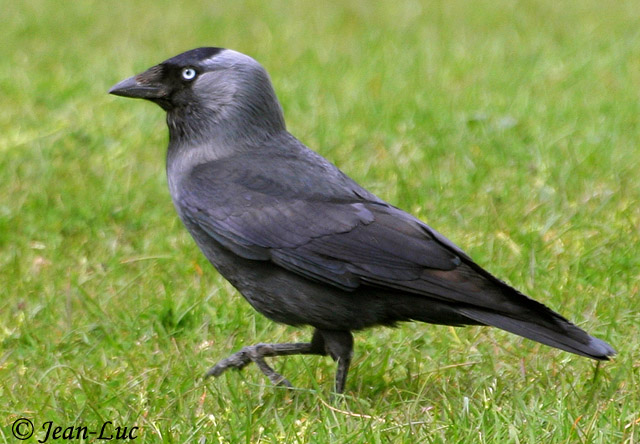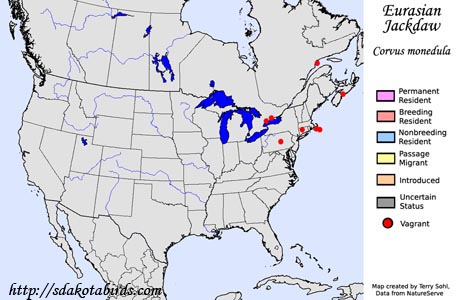| Length: 14 inches | Wingspan: 28 inches | Seasonality: Non-resident in South Dakota |
| ID Keys: Dark gray plumage overall, lighter nape and cheeks, black crown, short stout bill | ||
 The
Eurasian Jackdaw is native to most of Europe, parts of western Asia, and
parts of the Middle East. In North America, they are rare vagrants,
with a number of sightings in the northeastern United States and in eastern
Canada.
The
Eurasian Jackdaw is native to most of Europe, parts of western Asia, and
parts of the Middle East. In North America, they are rare vagrants,
with a number of sightings in the northeastern United States and in eastern
Canada.
Habitat: Found in a variety of open and semi-open habitats including agricultural fields and pastures, grasslands, and open woodlands. Birds typically roost in woodlands.
Diet: Omnivorous. Food items may include insects and insect larvae, earthworms, other small invertebrates, fruits, grains, seeds, nuts, eggs, young hatchlings, and refuse.
Behavior: Gregarious, typically found in flocks. Most foraging is done by walking along the ground.
Nesting: Jackdaw pairs often mate for life. The nest is constructed of sticks, placed in a cavity, either in a natural cavity such as in a tree, or also often in man-made cavities and crevices. The female lays between 4 and 6 eggs, and she alone incubates them. When the eggs hatch, both parents help feed the young, who leave the nest after about 4 weeks.
Song: Call of a Eurasian Jackdaw is a crisp "chek" sound.
Migration: Considered a permanent resident throughout much of their range in Eurasia. Some birds do migrate for the winter, including many of those in the northern portion of the breeding range, and many of those that breed in the interior part of Asia.
Interactive eBird Map: Click here to access an interactive eBird map of Eurasian Jackdaw sightings
Feeders: Will attend feeders for peanuts and other offered items.
Similar Species: With the lighter-gray plumage on the nape and head, the Eurasian Jackdaw can be differentiated from North American Crow and Raven species, if seen well.
Conservation Status: Populations are found over a wide geographic range, they are common in many areas, and populations may be increasing. The IUCN lists the Eurasian Jackdaw as a species of "Least Concern".
Further Information: 1) Royal Society for the Protection of Birds - Jackdaw
2) BirdLife International - Eurasian Jackdaw
3) ARKIVE.org - Eurasian Jackdaw
Photo Information: Photo taken by Jean-Luc - November 2nd, 2007 - Sully-sur-Loire, Centre, France - Photo licensed under Creative Commons Attribution NoDerivs 2.0 Generic License.
| Click below for a higher-resolution map |
 |
| South Dakota Status: Non-resident in South Dakota |
Additional Eurasian Jackdaw Photos (coming soon!!)
